Episode 147: STS-73 - Seventh Time's the Charm (USML-2)
Table of Contents
Columbia is back from the shop and is sporting some new upgrades, but seems reluctant to leave Earth on its 18th voyage. Once on orbit, we’ll do some science, learn why TV is good, and perform some magic tricks!
Episode Audio #
Photos #
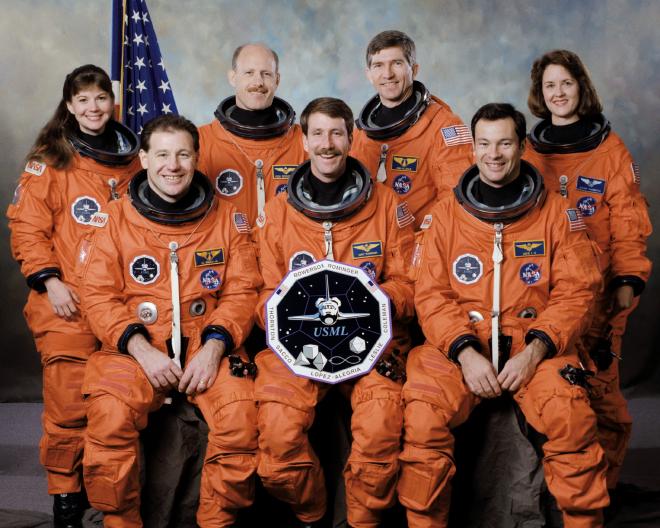
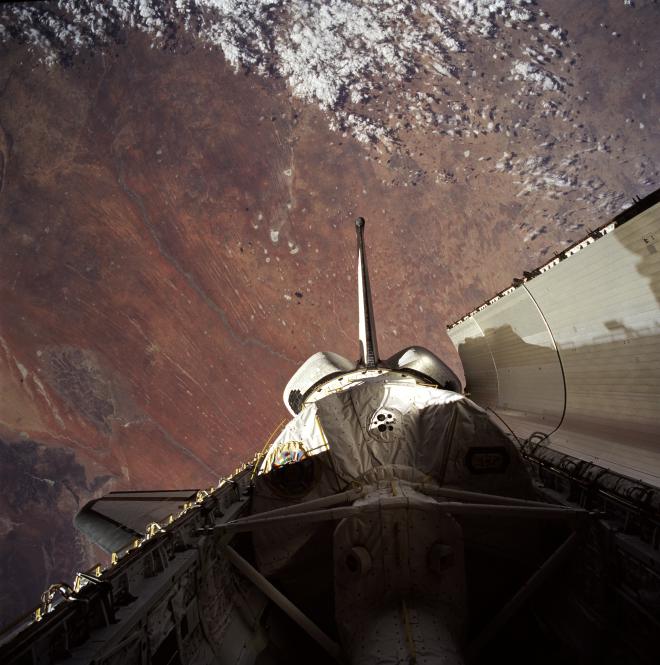
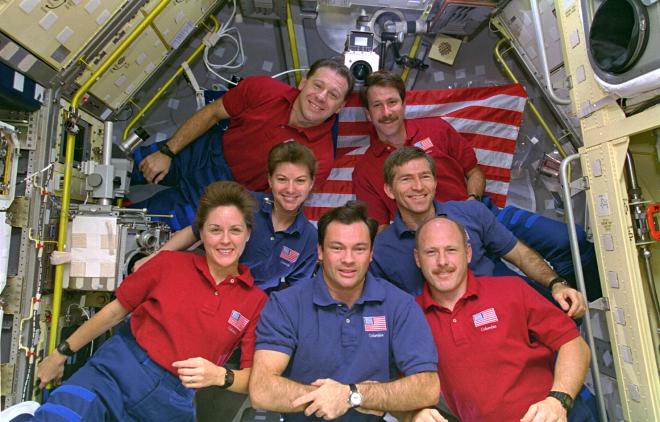
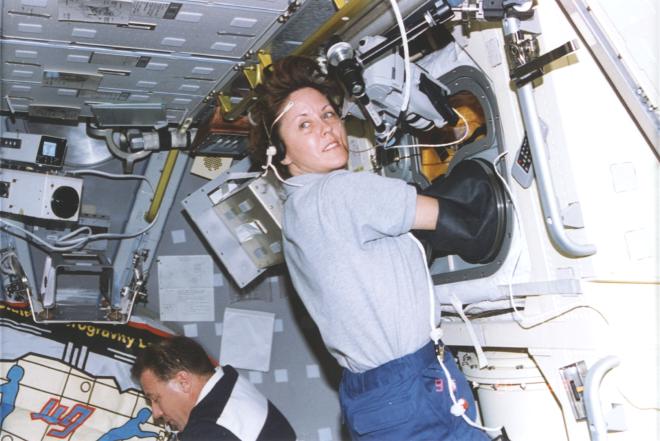
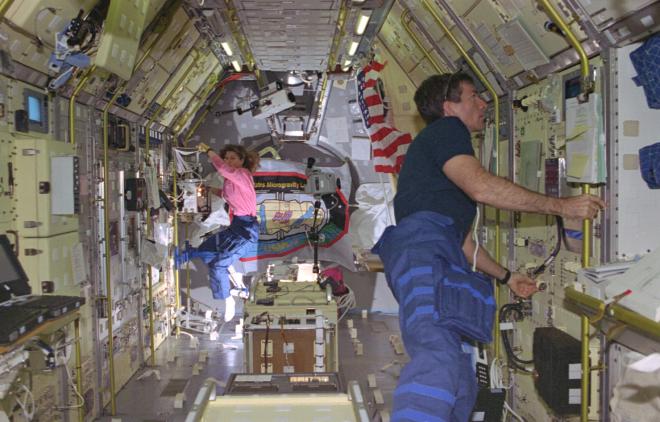
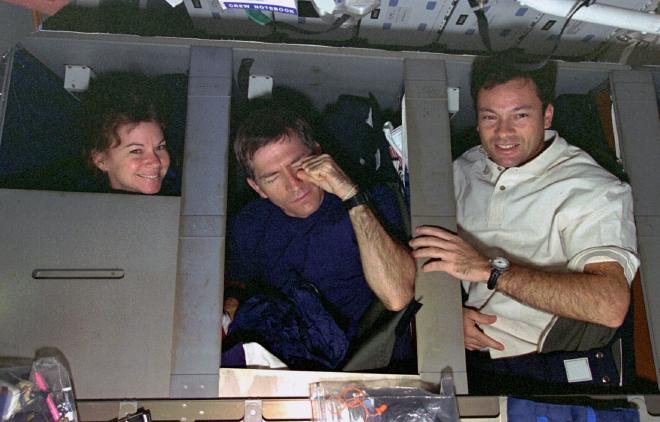
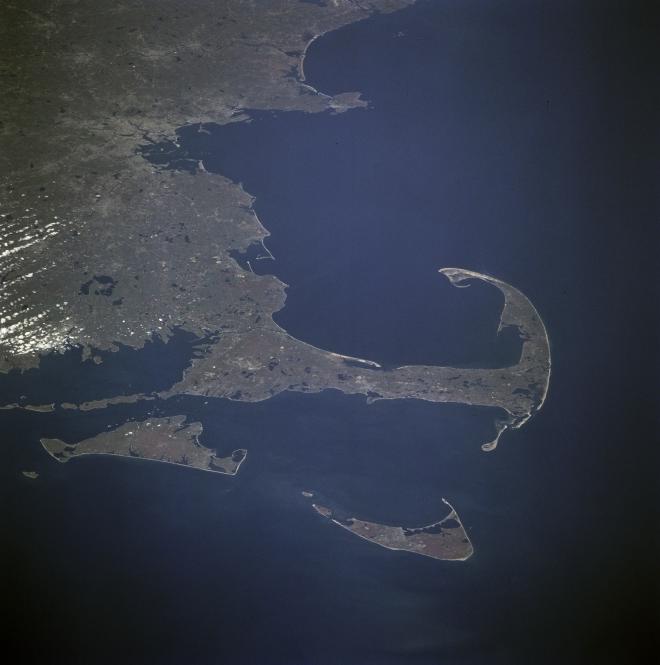
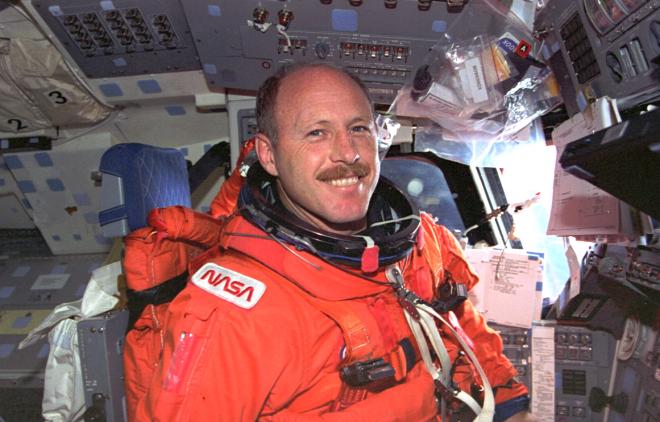
For more photos, head over to our friends at Wikiarchives.space: https://wikiarchives.space/index.php?/category/867
Post-Flight Presentation #
If you’d like to see the mission in motion you can check out the post-flight presentation here:
Transcript #
NOTE: This transcript was made by me just copying and pasting the script that I read to make the podcast. I often tweak the phrasing on the fly and then forget to update the script, so this is not guaranteed to align perfectly with the episode audio, but it should be pretty close. Also, since these are really only intended to be read by myself, I might use some funky punctuation to help remind myself how I want a sentence to flow, so don’t look to these as a grammar reference. If you notice any egregious transcription errors or notes to myself that I neglected to remove, feel free to let me know and I’ll fix it.
Hello, and welcome to The Space Above Us. Episode 147. Space Shuttle flight 72, STS-73: Seventh Time’s the Charm
Last time, we covered the action-packed flight of STS-69. Between SPARTAN, the Wake Shield Facility, and a bewildering number of dog references, STS-69 was certainly an attention grabbing mission. Today’s flight is a little less bombastic, but no less impactful. That’s because on STS-73 we’ve got more than two weeks of cutting edge material science lined up for US Microgravity Laboratory 2.
We’ve got a full house today, with our usual main crew size of five plus two payload specialists. And if that wasn’t enough, we’ve also got five people soaring past the Kármán line for the first time, so the crew section is going to be a little bigger than usual. We better just jump right in!
Commanding the flight, and riding on the left for the first time, was Ken Bowersox, who often went by the nickname ‘Sox’. We most recently saw Bowersox riding shotgun on STS-61, the first Hubble Servicing mission and this marks his third of five flights.
Helping Bowersox keep the orbiter happy and healthy during the lengthy flight would be our pilot for today’s mission, Kent Rominger. Kent Rominger was born on August 7th, 1956 in Del Norte (“nort”), Colorado. He didn’t travel too far from home for college, picking up a Bachelor’s degree in Civil Engineering from Colorado State University before heading off to learn how to fly planes with the United States Navy. After a few years flying F-14s onto and off of aircraft carriers, and attending the Navy Fighter Weapons School (aka TOPGUN), he went to the US Naval Postgraduate School and earned a Master’s in Aeronautical Engineering. He put that degree to use, working as a Project Officer for the F-14 and even performing the first carrier launch and landing using the new upgraded F-14B. Over the course of his career he’s logged over 7000 hours of flight time in over 35 types of aircraft, including 685 carrier landings. Well, he’s about to add one spacecraft to that list since he was selected as an astronaut in 1992 and this is his first of five flights.
Moving back to the mission specialists we meet Mission Specialist 1, Cady Coleman. Catherine Coleman was born on December 14th, 1960 in Charleston, South Carolina. She earned a Bachelor’s in Chemistry from the Massachusetts Institute of Technology and then joined the US Air Force. The Air Force put her to work at the Wright Patterson Air Force Base in Dayton, Ohio where she researched polymer synthesis and made compounds applicable to optics and advanced computer technology. Along the way she served as a surface analysis consultant for a little payload called the Long Duration Exposure Facility. She went back to Massachusetts and earned a doctorate in Polymer Science and Engineering from UMass before being selected as an astronaut the following year. This is her first of two shuttle flights, though she’ll supplement that with a Soyuz flight and a long duration stay aboard the ISS.
Continuing on, Mission Specialist 2 was Michael Lopez-Alegria. Michael Lopez-Alegria was born in Madrid, Spain but grew up in Mission Viejo, California. He earned a Bachelor’s in Systems Engineering from the US Naval Academy and eight years later earned a Master’s in Aeronautical Engineering from the US Naval Postgraduate School. In between, he became a Naval Aviator, serving as a flight instructor, pilot, and mission commander of the EP-3E aircraft. After earning his Master’s degree, he worked at the Naval Air Test Center as an engineering test pilot and a program manager. Over his career he racked up over 5700 hours of flying time in 30 different types of aircraft. He was selected as an astronaut in 1992 and this is his first of four flights.. for now. It was bound to happen eventually, and it’s happening today. With Michael Lopez-Alegria we have finally caught up enough with the present that at the time of this writing, he’s still not done flying. After this flight he’ll fly on the shuttle twice more and then once on the Soyuz, and as of late 2021 he is scheduled to command a Crew Dragon spacecraft on a privately funded mission to the ISS for the company Axiom Space.
Someone who sadly is not still flying is our second spaceflight vet for this mission: Kathy Thornton. We know KT most recently from STS-61 when she was climbing around outside the Hubble Space Telescope. But we also know her from STS-33, where she became the only woman to fly on a classified shuttle mission, and STS-49, known for its hair-raising capture of Intelsat on Endeavour’s first flight. With today’s mission, Thornton marks her fourth and final flight.
Moving on to the Payload Specialists, we meet Payload Specialist 1, Fred Leslie. Fred Leslie was born on December 19th, 1951 in Ancon, Panama. He holds a Bachelor’s in Engineering Science, along with a Master’s and PhD in Meteorology. When he wasn’t jumping out of perfectly good airplanes over 5500 times, Leslie was working as a scientist at the Marshall Space Flight Center in Huntsville, Alabama. He was a co-investigator for the Geophysical Fluid Flow Cell experiment that flew on Spacelab 3, and which is getting a followup on today’s flight, as well as several other shuttle science payloads. This is his first and only flight.
And finally, but no less importantly, Payload Specialist 2, Al Sacco. Alfred Sacco was born on May 3rd, 1949 in Boston, Massachusetts and grew up in nearby Belmont. He earned a Bachelor’s and a PhD in Chemical Engineering before heading just a few miles down the Mass Pike to Worcester, Massachusetts, where he joined the faculty of Worcester Polytechnic Institute. Fun fact, WPI is where Robert Goddard earned his undergraduate degree in Physics before he moved across town to my alma mater Clark University, where he worked on some sort of hobbyist rocket project that probably didn’t amount to much. This is Sacco’s first and only flight, but that wasn’t always the plan. In the early 2000s he was schedule to fly again as a Payload Specialist but was swapped for someone else, removing Sacco from the crew of STS-107. But that’s a story for another day.
Each mission’s road to space comes with its own unique twists and turns, and none of them are particularly easy. Sometimes things go mostly as expected, the systems and weather cooperate, and a crew is unstrapping from their weightless seats before they know it. And sometimes.. you get a flight like STS-73. For a similarly tortured path to orbit, the only comparable flight we can look to is STS-61C, way back in 1986, which scrubbed an incredible six times before finally rising from the launchpad. We’re not going to break that record today, but we will tie it.
Before we even get to the scrubs, we have a postponement. Due to concerns with the o-rings in the SRBs of STS-71 and STS-70, STS-69 had repairs done to the nozzle joints on its SRBs. So while the SRBs on this flight were fine, the mission was pushed back 20 days thanks to the previous mission needing extra time.
The first launch attempt was scheduled for September 28th but had to be scrubbed when hydrogen was detected leaking from a main engine fuel valve. One week later, we’re ready to try again, but the folks in the weather office predicted unacceptably high winds and lightning risk from the nearby Hurricane Opal. That was only a one day delay though, so on October 6th they tried again, only to encounter a problem with the hydraulics in Columbia’s nose gear steering system. These hydraulics are pretty important because without it, the crew would have much less effective steering upon landing. I’m not entirely sure how this happened, but there somehow wasn’t enough hydraulic fluid in the system, and it sounds like somehow this happened due to the fuel valve replacement. Maybe they had to partially bleed the hydraulics system in order to replace the valve? I have no idea. Anyway, let’s not get to bogged down because we’re only halfway there.
The next day, on October 7th, they tried again, and made it all the way to the T-20 minutes hold when one of the two Master Event Controllers failed. This is no good, since the Master Event Controller is what fires off the pyrotechnics to separate the SRBs from the launchpad, then later to separate the SRBs from the shuttle stack, and separate the External Tank from the orbiter, among other things. So you really want to make sure it’s working right. The launch was pushed another seven days to the right.
During that downtime, a crack was discovered in a high pressure oxidizer duct weld in an engine that was being tested NASA’s Stennis Space Center. An inspection of Columbia’s welds had to be conducted before continuing on, so the launch that had been scheduled for the next day was scrubbed and moved forward one more day. And just for good measure, during this time, general purpose computer 1 on the orbiter failed and had to be replaced, but that didn’t pile on any additional delays.
Lastly, attempt number six, on October 15th was scrubbed at the T-5 minute mark thanks to low clouds and rain.
All of this would bad enough for any crew, but I have to imagine that with five first-time fliers they must have been going out of their minds.
Finally, though, we arrive at the real launch date, October 20th, 1995. The fact that the seventh attempt will get off the launchpad can be attributed to a few things. Clear weather, lack of systems problems, and the blood sweat and tears of an army of technicians and engineers, sure.. but if you ask the crew, there were a couple extra things that made the difference. Kathy Thornton claims that wearing her lucky socks helped things fall in line. Or perhaps it was because the crew all turned their mission-specific baseball hats around backwards when emerging from the Operations and Checkout building on the way to the Astrovan, since clearly wearing them facing forwards was cursing the flight. Whatever it is, it worked, but it almost didn’t.
As the crew were being strapped into their seats, a fire alarm sounded, but it turned out to just be a false alarm. A little trick from the gods of chaos that had kept Columbia grounded so far. Then in the final minutes before launch, liftoff was delayed by a further three minutes due to a signal problem with the range safety system. But at long last, on October 20th, 1995, at 9:53 am, Columbia lifted off for the 18th time, much to the relief of everyone involved, I’m sure.
Powering its ride uphill were two of the new Block 1 engines that we introduced on STS-70, along with one of the older type, with all three engines performing flawlessly. 8 minutes and 29-and-a-half seconds after lifting off, the main engines shut down, and the crew of STS-73 had finally arrived on orbit. Fun fact, among the five rookies on this flight was the 200th person to fly on the shuttle. I’ll go with Pilot Rominger because he was the rookie with the most altitude at the moment of launch thanks to his seat up front.
As usual, the first order of business when arriving in space was to open the payload bay doors and deploy the Ku-band antenna. I usually don’t mention the antenna, but with today’s mission being so heavy on telescience it will have an especially important role. Once the payload bay doors were open, the antenna was able to swivel out over the edge of the starboard side of the payload bay and begin tracking whichever TDRS was in view at the time.
One thing that wasn’t usual was that this time the port payload bay door was left part-way closed, such that it stuck out in the same direction as the tail, rather than its usual position which was more or less parallel with the wings. The reason for this was that with all the sensitive material science experiments that were planned, Columbia would be remaining in a gravity gradient stabilized attitude, minimizing the required thruster firings. This meant that Columbia would be flying along with its tail facing the Earth, its nose facing space, and its left side facing the direction of travel. Since the flight was planned to last over two weeks, there was a concern that a micrometeoroid might hit the radiator mounted on the port-side payload bay door. To prevent that, it was partially closed, so any debris would hit the outside of the door instead of the radiator. So now when you see photos of STS-73, as we all do from time to time, you’ll know why one of the payload bay doors was only half open!
Once the doors were open (mostly) and the antenna was deployed, the crew split up into the two teams that would enable them to perform science around the clock. The red team consisted of Commander Bowersox, Pilot Rominger, Mission Specialist and Payload Commander Thornton, and Payload Specialist Sacco. The blue team was Mission Specialists Coleman and Lopez-Alegria, and Payload Specialist Leslie. But this meant that the poor blue team had to try to set aside all the excitement of liftoff and climb into their bunks and try to sleep. Cady Coleman called it the hardest part of the entire flight.
While the blue team tried to force themselves to sleep, the red team got to work activating Spacelab. Normally, the crew is given some extra time on the first day with the assumption that there will be minor problems getting systems set up, or with spaceflight rookies keeping their lunches down. But perhaps making up for the troublesome effort to get off the launchpad, day one went super smoothly. The result was that the crew were able to do some get-ahead tasks and really get the orbiting laboratory fully kitted out and ready for the two weeks of science to come.
Before getting into that science, we’ll let the crew finish setting up Spacelab and will take a look around at Columbia. It’s been a while since we’ve seen OV-102, which last flew a little more than a year ago on STS-65, the International Microgravity Laboratory 2 mission. That’s because it’s been in the shop undergoing a series of upgrades. Among those upgrades was some updated wiring that would allow the crews to access downlinked telemetry from laptops, some new filters for hydrogen flow valves so they’d be less prone to contamination, and a series of small improvements to reduce structural corrosion. After all, these vehicles spend more time parked out in the open next to the ocean, and all its saltwater spray, than they do in space. These periodic improvements don’t always seem like much in the moment, but when looked at as a whole, they really help keep the orbiter fleet moving forward and evolving. With each iteration operations get easier, the vehicles get safer, and the scope of the missions expands. Remember when shuttle missions used to only last a few days and didn’t even have radio contact the whole time, let alone round the clock video? These things can sneak up on you.
Now that everything’s all set up, let’s take a look at the experiments. Today, we’re really only going to take a cursory look at these experiments. I know I sort of say this every time, but with most of these experiments being re-flown from USML-1, and with tomorrow being Thanksgiving here in the United States, I’m going to give myself a little break and the coverage will be just a bit lighter than usual. Remember when this show used to be 20 minutes? Yeah me neither. Right off the bat, anything involving a crystal is getting skipped. That’s gonna bum out Payload Specialist Al Sacco since he’s the principal investigator on an experiment looking at a special type of crystal called a zeolite, but he’ll just have to deal. As always, if anyone would like to dig deeper, just let me know and I’d be happy to point you in the direction of some of the resources I use to put an episode together.
Let’s start with the crew’s favorite: the Drop Physics Module. This is an apparatus dedicated to the study and manipulation of free-floating drops, or blobs, of fluid. The crew would inject fluid into the test chamber and then operate several audio speakers positioned around the chamber. By carefully controlling the vibrations coming from the speakers, it was possible to move the blobs around, spin them, and break them apart. It’s basically the Wingardium Leviosa chamber. The crew enjoyed it because the drops could be manipulated into some pretty interesting states. Sometimes they would oscillate through a bunch of cool shapes, or would spin fast enough that they were two drops connected by a thin bridge. And that sounds just plain fun. But also, by using several cameras placed at different angles, it was possible to learn a lot about fluid dynamics in a way that was just not possible on the ground. Among other experiments, the module was used to learn when spinning drops would break apart, the behavior of different types of fluid brought in contact with each other, and the behavior of bubbles placed inside the drops. On top of that, additives that changed the surface tension and other properties of the fluid could be added, which helped scientists figure out the role of those properties in the overall behavior. Plus, like I said, it looked really cool.
Another interesting experiment was the Geophysical Fluid Flow Cell Experiment, or GFFC. GFFC flew way back on STS-51B but I apparently missed it, which is a shame because it’s actually pretty cool. The experiment comprised a hemisphere roughly the size of a basketball, around 23 centimeters across, with a second hemisphere at its center that was about the size of a baseball, around 7.5 centimeters across. In between the basketball layer and baseball layer, which is apparently what I’m going with, was a bunch of silicone oil with carefully controlled properties. By using the geometry of these two hemispheres, the weightless environment, the properties of the silicone oil, and some careful heating, it was possible to emulate the movement of the Earth’s mantle. This layer of fluid rock deep below the surface is obviously pretty difficult to study directly, but with this clever analogous experiment it was possible to learn a great deal about its dynamics. In addition to simulating the mantle, the GFFC was run through nearly 30 different scenarios that tested the dynamics of oceans, atmospheres, planets, and stars. Early results even indicated that it had validated predictions made by a mathematical model of fluid inside planets and stars. It’s a pretty neat little experiment.
One last experiment I’ll quickly mention was the Fiber Supported Droplet Combustion experiment. We’ve seen a few payloads trying to better understand how combustion works in microgravity, but apparently a common problem is that when you light something on fire in space it starts to move around, making it harder to study. So as the name suggests, this time, a droplet of combustible material was placed on a string. When it was lit on fire, it would move around on the string, but at least that’s only one axis to keep track of. And if you’re thinking that lighting balls of combustible fluids on fire in microgravity on the space shuttle sounds dangerous, don’t worry, they did it inside the self-contained glovebox apparatus.
One significant improvement to this round of Spacelab experiments was the addition of a new system that allowed the orbiter to downlink six simultaneous television feeds at once. As we’ve seen, the scientific return of these experiments is greatly enhanced by having scientists on the ground participate in the experiment remotely, in a process NASA called telescience. That’s great, but with only one video feed available, that video feed quickly became a bottleneck. With this new system, not only could a video feed be dedicated to each experiment being operated by a crew member, they could even be used on unattended experiments that were being operated from the ground. This was a huge breakthrough in how shuttle-based science could be performed and it presaged how it would be done on the space station. In fact, there’s a room I like to walk past at the Goddard Space Flight Center which shows a bunch of raw footage from various onboard cameras on the ISS, and if I’m lucky I can sometimes see one beaming down some experiment in progress.
One other advantage of this approach was that at the end of the mission, most of the principal investigators already had all the raw data from their experiments and could go start crunching through it. This is quite an improvement to the last time the US Microgravity Laboratory flew when scientists would have to wait upwards of seven months to finally get their data.
It’s also worth mentioning that there were a few smaller experiments being operated up on the middeck, getting science done even outside of Spacelab. One noteworthy experiment was the last test flight of the Astroculture apparatus. We’ve seen Astroculture fly a few times now as it incrementally built up the ability to grow plants in space. Well on this flight the goal was to test out the nutrient and water delivery system, and what better test than to actually grow some plants. So among all the various crystals that were being grown on this mission, we can add ten small potatoes to the list. Maybe we can combine them with the fiber supported droplet combustion chamber and make some fries.
With such a long flight and with this handy dandy new video system, the video downlinks contained more than just raw science data. The crew walked through a number of experiments with students at a few different schools around the world, including one in Payload Specialist Sacco’s adopted hometown of Worcester, Massachusetts. Later, in an a remarkable feat of flight dynamics, the crew gathered around to watch Commander Ken Bowersox throw out the first pitch at the fifth game of the 1995 World Series. Bowersox gently threw a baseball towards the camera, and then suddenly, captured by TV cameras on the ground, a baseball came falling out of the black night sky over the stadium! It didn’t exactly hit the strike zone but that’s not bad for a ball being thrown from a vehicle at almost 8 kilometers per second. Or.. I dunno, I’m guessing a helicopter over the stadium. But let’s not ruin the illusion.
And actually, speaking of illusions, during the crew’s downtime they even found an opportunity to do a little magic! The video footage is pretty incredible. Down in Spacelab, Cady Coleman lies down on the floor of the laboratory while Al Sacco stands above her. Sacco performs some mystical motions and says the magic words and suddenly Coleman began to rise up from the floor, seemingly levitating! Sacco duly waved his arms above and below the flying Mission Specialist to demonstrate that there were, indeed, no wires supporting her. Wow, spaceflight is magic.
Despite the nearly record-breaking duration of the flight, there were hardly any issues with the orbiter. There were a few minor problems with some vernier thrusters, one of the computer screens started flashing, and various pieces of equipment were at slightly different temperatures than expected, requiring some intervention, but really, Columbia was essentially perfect. As the crew made preparations to come home, the orbiter’s belly was pointed towards the sun for an extended period to warm everything up and ensure that the landing gear tires were at a sufficient temperature and pressure to perform a safe landing. And after an uneventful deorbit burn and reentry, they did just that, as Columbia touched down at the Kennedy Space Center and completed the second-longest shuttle flight to date. Its total duration of 15 days, 21 hours, 52 minutes, and 21 seconds was less than two minutes off of the prediction printed in the press kit weeks before liftoff.
I always feel like I do missions like this a disservice, so I want to emphasize that the flight of USML-2 was an important one. We all love free-flying payloads and innovative spacewalks, and it can sometimes be tough to get excited about yet another high quality crystal, but these quieter flights are truly delivering on one of the core promises of the space shuttle. STS-73 returned a mountain of data that simply wasn’t possible to generate anywhere on Earth, advancing our understanding on everything from fluid dynamics, capillary action, protein structures, phase transitions, surface tension, surfactants, and even the behavior of molten rock thousands of miles below our feet. The flight also further refined the planned operations of the upcoming space station, ensuring that future crews would be able to hit the ground running. Well, float in the air running. Something like that.
Next time, it’s been a little while since we visited Mir, so I think it’s time to return to our favorite Russian space station. But this time, we won’t be carrying any hitchhikers.
Ad Astra, catch you on the next pass.
